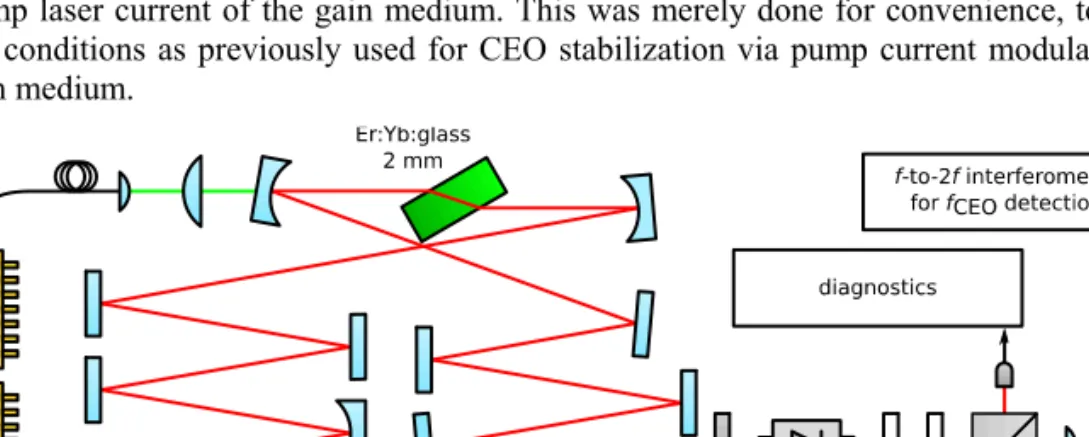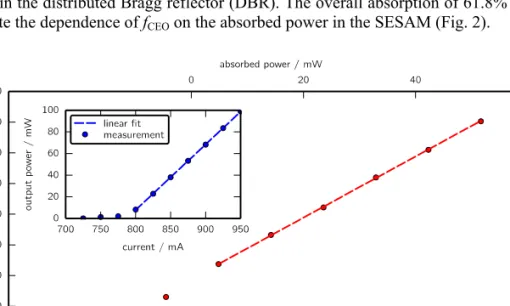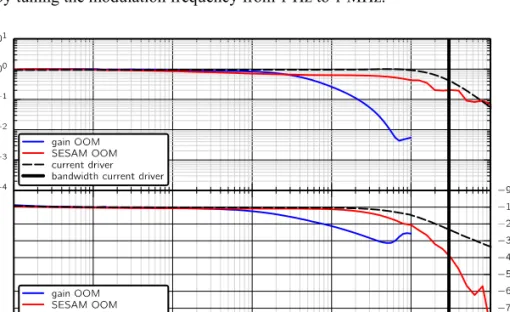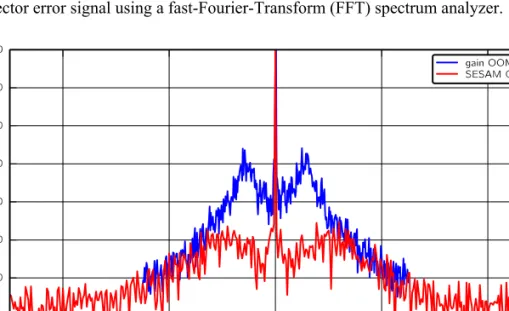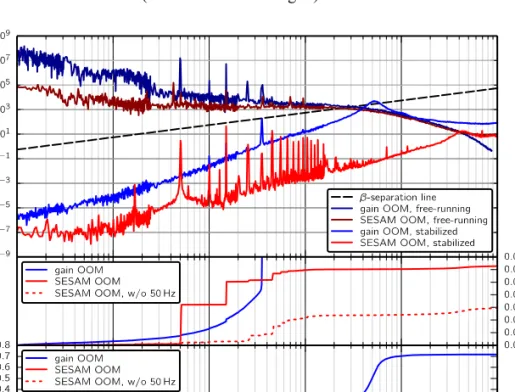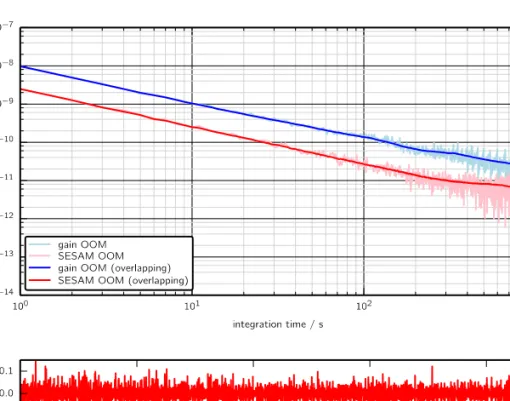CEO stabilization of a femtosecond laser using a
SESAM as fast opto-optical modulator
Martin Hoffmann,* Stéphane Schilt, and Thomas Südmeyer
Laboratoire Temps-Fréquence, Université de Neuchâtel, Avenue de Bellevaux 51, CH-2000 Neuchâtel, Switzerland *martin.hoffmann@unine.ch
Abstract: We present a new method for intra-cavity control of the carrier-envelope offset (CEO) frequency of ultrafast lasers that combines high feedback bandwidth with low loss, low nonlinearity, and low dispersion. A semiconductor saturable-absorber mirror (SESAM) inside a modelocked laser is optically pumped with a continuous-wave (cw) laser. In this way, the SESAM acts as intra-cavity opto-optical modulator (OOM): the optical power of the cw-laser corresponds to a high-bandwidth modulation channel for CEO frequency control. We experimentally verified this method for a femtosecond Er:Yb:glass oscillator (ERGO), in which one SESAM is in parallel used for modelocking and as intra-cavity OOM for achieving a tight CEO lock. This laser can also be CEO-stabilized in the usual scheme, in which the laser pump current is modulated, i.e., the gain element acts as intra-cavity OOM. We compare the performance with gain and SESAM OOM measuring CEO transfer function, frequency noise power spectral density (PSD), and Allan deviation for integration times up to 1000 s. In the case of the gain OOM, the millisecond upper-state lifetime of the Er:Yb:glass limits the achievable CEO-control bandwidth to <10 kHz. The feedback bandwidth of the SESAM OOM was more than a factor of 10 higher than the gain OOM bandwidth and was mainly limited by the used current driver. The residual integrated phase noise (1 Hz – 100 kHz) of the ~20-MHz CEO beat was improved by more than an order of magnitude (from 720 mrad to less than 65 mrad), and the fractional frequency stability by a factor of 4 (from 1·10−8 to 2.5·10−9 at 1 s).
OCIS codes: (140.4050) Mode-locked lasers; (140.7090) Ultrafast lasers. References and links
1. T. W. Hänsch, “Nobel lecture: passion for precision,” Rev. Mod. Phys. 78(4), 1297–1309 (2006).
2. J. Ye, H. Schnatz, and L. W. Hollberg, “Optical frequency combs: from frequency metrology to optical phase control,” IEEE J. Sel. Top. Quantum Electron. 9(4), 1041–1058 (2003).
3. S. A. Diddams, T. Udem, J. C. Bergquist, E. A. Curtis, R. E. Drullinger, L. Hollberg, W. M. Itano, W. D. Lee, C. W. Oates, K. R. Vogel, and D. J. Wineland, “An Optical Clock Based on a Single Trapped 199Hg+ Ion,” Science 293(5531), 825–828 (2001).
4. U. Sterr, C. Degenhardt, H. Stoehr, C. Lisdat, H. Schnatz, J. Helmcke, F. Riehle, G. Wilpers, C. Oates, and L. Hollberg, The Optical Calcium Frequency Standards of PTB and NIST (2004).
5. F. Quinlan, T. M. Fortier, M. S. Kirchner, J. A. Taylor, M. J. Thorpe, N. Lemke, A. D. Ludlow, Y. Jiang, and S. A. Diddams, “Ultralow phase noise microwave generation with an Er:fiber-based optical frequency divider,” Opt. Lett. 36(16), 3260–3262 (2011).
6. H. R. Telle, G. Steinmeyer, A. E. Dunlop, J. Stenger, D. H. Sutter, and U. Keller, “Carrier-envelope offset phase control: A novel concept for absolute optical frequency measurement and ultrashort pulse generation,” Appl. Phys. B 69(4), 327–332 (1999).
7. G. Di Domenico, S. Schilt, and P. Thomann, “Simple approach to the relation between laser frequency noise and laser line shape,” Appl. Opt. 49(25), 4801–4807 (2010).
8. J. Rauschenberger, T. Fortier, D. Jones, J. Ye, and S. Cundiff, “Control of the frequency comb from a modelocked Erbium-doped fiber laser,” Opt. Express 10(24), 1404–1410 (2002).
9. B. R. Washburn, S. A. Diddams, N. R. Newbury, J. W. Nicholson, M. F. Yan, and C. G. Jørgensen, “Phase-locked, erbium-fiber-laser-based frequency comb in the near infrared,” Opt. Lett. 29(3), 250–252 (2004).
10. P. Pal, W. H. Knox, I. Hartl, and M. E. Fermann, “Self referenced Yb-fiber-laser frequency comb using a dispersion micromanaged tapered holey fiber,” Opt. Express 15(19), 12161–12166 (2007).
11. S. Schilt, N. Bucalovic, V. Dolgovskiy, C. Schori, M. C. Stumpf, G. Di Domenico, S. Pekarek, A. E. H. Oehler, T. Südmeyer, U. Keller, and P. Thomann, “Fully stabilized optical frequency comb with sub-radian CEO phase noise from a SESAM-modelocked 1.5-µm solid-state laser,” Opt. Express 19(24), 24171–24181 (2011). 12. S. A. Meyer, J. A. Squier, and S. A. Diddams, “Diode-pumped Yb:KYW femtosecond laser frequency comb
with stabilized carrier-envelope offset frequency,” Eur. Phys. J. 48, 19–26 (2008).
13. A. Klenner, F. Emaury, C. Schriber, A. Diebold, C. J. Saraceno, S. Schilt, U. Keller, and T. Südmeyer, “Phase-stabilization of the carrier-envelope-offset frequency of a SESAM modelocked thin disk laser,” Opt. Express 21(21), 24770–24780 (2013).
14. O. Pronin, M. Seidel, J. Brons, F. Lücking, V. Pervak, A. Apolonski, T. Udem, and F. Krausz, “Carrier-envelope phase stabilized thin-disk laser,” in Proceedings, ASSL Conference (2013), p. AF3A.5.
15. K. Kim, B. R. Washburn, G. Wilpers, C. W. Oates, L. Hollberg, N. R. Newbury, S. A. Diddams, J. W. Nicholson, and M. F. Yan, “Stabilized frequency comb with a self-referenced femtosecond Cr:forsterite laser,” Opt. Lett. 30(8), 932–934 (2005).
16. P. W. Roth, A. J. Maclean, D. Burns, and A. J. Kemp, “Direct diode-laser pumping of a mode-locked Ti:sapphire laser,” Opt. Lett. 36(2), 304–306 (2011).
17. R. Holzwarth, T. Udem, T. W. Hänsch, J. C. Knight, W. J. Wadsworth, and P. S. J. Russell, “Optical Frequency Synthesizer for Precision Spectroscopy,” Phys. Rev. Lett. 85(11), 2264–2267 (2000).
18. D. J. Jones, S. A. Diddams, J. K. Ranka, A. Stentz, R. S. Windeler, J. L. Hall, and S. T. Cundiff, “Carrier-Envelope Phase Control of Femtosecond Mode-Locked Lasers and Direct Optical Frequency Synthesis,” Science 288(5466), 635–639 (2000).
19. J. J. McFerran, W. C. Swann, B. R. Washburn, and N. R. Newbury, “Suppression of pump-induced frequency noise in fiber-laser frequency combs leading to sub-radian f ceo phase excursions,” Appl. Phys. B 86(2), 219– 227 (2007).
20. C. Benko, A. Ruehl, M. J. Martin, K. S. E. Eikema, M. E. Fermann, I. Hartl, and J. Ye, “Full phase stabilization of a Yb:fiber femtosecond frequency comb via high-bandwidth transducers,” Opt. Lett. 37(12), 2196–2198 (2012).
21. C.-C. Lee, C. Mohr, J. Bethge, S. Suzuki, M. E. Fermann, I. Hartl, and T. R. Schibli, “Frequency comb stabilization with bandwidth beyond the limit of gain lifetime by an intracavity graphene electro-optic modulator,” Opt. Lett. 37(15), 3084–3086 (2012).
22. D. A. Walsh, C. E. Crombie, W. Sibbett, C. T. A. Brown, V. G. Savitski, D. Burns, and S. Calvez, “Optically-induced switching between mode-locked and unmode-locked continuous wave regimes of a femtosecond Cr4+:forsterite laser,” in (2012), Vol. 8433, p. 84330G–84330G–10.
23. G. Baili, M. Alouini, L. Morvan, D. Dolfi, A. Khadour, S. Bouchoule, and J.-L. Oudar, “Timing Jitter Reduction of a Mode-Locked VECSEL Using an Optically Triggered SESAM,” IEEE Photon. Technol. Lett. 22(19), 1434– 1436 (2010).
24. C. J. Saraceno, C. Schriber, M. Mangold, M. Hoffmann, O. H. Heckl, C. R. Baer, M. Golling, T. Südmeyer, and U. Keller, “SESAMs for High-Power Oscillators: Design Guidelines and Damage Thresholds,” IEEE J. Sel. Top. Quantum Electron. 18(1), 29–41 (2012).
25. C. J. Saraceno, F. Emaury, O. H. Heckl, C. R. E. Baer, M. Hoffmann, C. Schriber, M. Golling, T. Südmeyer, and U. Keller, “275 W average output power from a femtosecond thin disk oscillator operated in a vacuum environment,” Opt. Express 20(21), 23535–23541 (2012).
26. M. C. Stumpf, S. Pekarek, A. E. H. Oehler, T. Südmeyer, J. M. Dudley, and U. Keller, “Self-referencable frequency comb from a 170-fs, 1.5-μm solid-state laser oscillator,” Appl. Phys. B 99(3), 401–408 (2010). 27. G. J. Spühler, K. J. Weingarten, R. Grange, L. Krainer, M. Haiml, V. Liverini, M. Golling, S. Schön, and U.
Keller, “Semiconductor saturable absorber mirror structures with low saturation fluence,” Appl. Phys. B 81(1), 27–32 (2005).
28. P. Yeh, Optical Waves in Layered Media (Wiley, 2005).
29. S. Schilt, N. Bucalovic, L. Tombez, V. Dolgovskiy, C. Schori, G. Di Domenico, M. Zaffalon, and P. Thomann, “Frequency discriminators for the characterization of narrow-spectrum heterodyne beat signals: Application to the measurement of a sub-hertz carrier-envelope-offset beat in an optical frequency comb,” Rev. Sci. Instrum. 82(12), 123116 (2011).
30. N. Bucalovic, V. Dolgovskiy, M. C. Stumpf, C. Schori, G. Di Domenico, U. Keller, S. Schilt, and T. Südmeyer, “Effect of the carrier-envelope-offset dynamics on the stabilization of a diode-pumped solid-state frequency comb,” Opt. Lett. 37(21), 4428–4430 (2012).
31. U. Keller, “Ultrafast solid-state laser oscillators: a success story for the last 20 years with no end in sight,” Appl. Phys. B 100(1), 15–28 (2010).
32. E. Wolf, Progress in Optics (Elsevier, 2006).
33. D. J. H. C. Maas, A. R. Bellancourt, M. Hoffmann, B. Rudin, Y. Barbarin, M. Golling, T. Südmeyer, and U. Keller, “Growth parameter optimization for fast quantum dot SESAMs,” Opt. Express 16(23), 18646–18656 (2008).
34. A. Klenner, M. Golling, and U. Keller, “A gigahertz multimode-diode-pumped Yb:KGW enables a strong frequency comb offset beat signal,” Opt. Express 21(8), 10351–10357 (2013).
35. S. Pekarek, A. Klenner, T. Südmeyer, C. Fiebig, K. Paschke, G. Erbert, and U. Keller, “Femtosecond diode-pumped solid-state laser with a repetition rate of 4.8 GHz,” Opt. Express 20(4), 4248–4253 (2012). 36. S. Pekarek, T. Südmeyer, S. Lecomte, S. Kundermann, J. M. Dudley, and U. Keller, “Self-referenceable
frequency comb from a gigahertz diode-pumped solid-state laser,” Opt. Express 19(17), 16491–16497 (2011). 37. H.-W. Chen, G. Chang, S. Xu, Z. Yang, and F. X. Kärtner, “3 GHz, fundamentally mode-locked, femtosecond
Yb-fiber laser,” Opt. Lett. 37(17), 3522–3524 (2012).
38. T. Südmeyer, S. V. Marchese, S. Hashimoto, C. R. E. Baer, G. Gingras, B. Witzel, and U. Keller, “Femtosecond laser oscillators for high-field science,” Nat. Photonics 2(10), 599–604 (2008).
39. C. J. Saraceno, S. Pekarek, O. H. Heckl, C. R. E. Baer, C. Schriber, M. Golling, K. Beil, C. Kränkel, G. Huber, U. Keller, and T. Südmeyer, “Self-referenceable frequency comb from an ultrafast thin disk laser,” Opt. Express 20(9), 9650–9656 (2012).
1. Introduction
Optical frequency combs from modelocked lasers have revolutionized numerous research areas in time-frequency and optical metrology in the last decade. By providing a direct and phase-coherent link between optical and microwave frequencies, they have enabled the measurement of optical frequencies with extreme precision [1,2]. This resulted in the development of novel optical atomic clocks with unprecedented frequency stability [3,4]. Moreover, they constitute a key element of ultra-low noise microwave oscillators [5]. The basic technology for all these applications is the self-referencing of the frequency comb, i.e, the stabilization of the carrier-envelope offset (CEO) frequency in order to obtain a perfectly defined frequency grid. The CEO frequency is traditionally detected using an f-to-2f interferometer [6]. The required octave-spanning coherent spectrum is usually generated in a highly non-linear fiber (HNLF). The actual stabilization of the CEO beat can be realized using an electronically-controllable actuator that needs to influence the CEO beat frequency. One of the most important requirements on that actuator is that it exhibits a sufficiently large modulation bandwidth. As a rule-of-thumb, the required bandwidth is approximated by the crossing point of the frequency noise power spectral density (PSD) of the free-running CEO beat with the β-separation line introduced by Di Domenico et al. [7].
The traditional method to stabilize the CEO frequency is to modulate the pump power. This can be realized in two ways. If the laser can be directly diode-pumped, which is the case for standard ultrafast fiber lasers and diode-pumped solid-state lasers (DPSSL), direct modulation of the injection current of the pump laser diode can be applied. Otherwise, an additional optical modulator such as an acousto-optical modulator (AOM) has to be inserted into the pump beam. Modulation of the pump current can be realized straightforwardly since it does not require additional elements to be introduced in the laser cavity or pump beam. Self-referencing of fiber lasers and DPSSLs directly benefits from this technique, which constitutes the standard stabilization method for these combs [8]. Using this approach, CEO stabilization with sub-radian integrated phase noise was achieved for various gain materials and laser systems, e.g. Er [5,9] and Yb [10] fiber lasers, Er:Yb:glass [11], Yb:KYW [12], Yb:CALGO thin disk lasers [13], Yb:YAG thin disk lasers [14], or Cr:forsterite [15] DPSSLs, with a feedback loop bandwidth typically ranging from a few kHz [11] up to several tens of kHz [5]. The most important ultrafast laser which so far cannot be efficiently diode pumped [16] is the Ti:Sapphire laser. Ti:sapphire lasers [6,17,18], which were the first demonstrated frequency combs, typically use an AOM to modulate the pump beam as a CEO actuator. It should be noted that both of these techniques modulate the gain of the laser resonator. However, the modulation bandwidth of such a gain material is limited by the upper-state lifetime of these gain materials. For many important diode-pumped Yb and Er gain materials, the upper-state lifetime is in the millisecond range, limiting the feedback bandwidth to the kHz-regime. In order to access the feedback bandwidth required to achieve a tight CEO phase-lock, the use of a phase-lead filter was often necessary to extend the overall bandwidth beyond the limit of the gain lifetime [19]. Further increasing the stabilization bandwidth, for instance to achieve a better lock or to phase-lock lasers with a larger CEO linewidth, requires another approach to act on the CEO beat frequency. The limitation given by the gain lifetime
can be circumvented by the direct use of intra-cavity loss-modulation. In such a case, a larger bandwidth limited by the recovery time of the loss-modulator can be achieved. Intra-cavity AOMs or intra-cavity electro-optical modulators (EOMs) are examples for such CEO actuators. Whereas these techniques were successfully used to stabilize the CEO frequency [20] and while they do offer a large modulation bandwidth, they have several disadvantages. First, an additional element needs to be inserted into the laser cavity. This can be a challenge especially for high repetition rate lasers in the GHz range, where geometrical constraints can limit such an approach. Furthermore, intra-cavity AOMs and transmission EOMs can exhibit high nonlinearity, which can destabilize or prevent modelocked operation of the laser, and they can cause to thermal lensing. Very recently, a graphene EOM was used in reflection to stabilize the CEO frequency in a Tm-fiber similariton oscillator [21]. While a large feedback loop bandwidth of >1 MHz was demonstrated using this technique, the intra-cavity graphene EOM does not seem to be suitable for the stabilization of high-power lasers, due to the relatively high non-saturable losses (<5%) of the absorber material, in comparison to the available pulse modulation (2%). Furthermore, such an approach is not power-scalable because of the required lateral current injection and the fixed aperture of the graphene EOM.
Here, we present a high-bandwidth loss modulator that acts on the CEO beat frequency by optically pumping the intra-cavity SESAM of a modelocked laser. Optical feedback to a SESAM was previously used to enable fast switching of a laser between continuous wave (cw) and modelocked operation [22], and also to change the cavity length of a laser [23]. In our experiment demonstrated here, we use opto-optical modulation (OOM) of the SESAM as an actuator for CEO frequency control of the modelocked laser. Considering the short recombination time of the absorber of the SESAM, which can be in the order of tens of picoseconds, there does not seem to be any practical limit for the bandwidth of this actuator. Moreover, this high-bandwidth modulation channel offers low dispersion, low thermal lensing, and low losses and is therefore extendable to high-power lasers as well. This is possible because SESAM exhibit extremely high damage thresholds [24], which enabled modelocked lasers with record-high average output power up to 275 W [25]. In our proof-of-principle demonstration, we used a low power 110 mW SESAM-modelocked DPSSL to demonstrate the suitability of the proposed modulation technique in comparison with previously published results obtained using the exact same laser [11] with the standard method of pump current modulation. It was not necessary to make any changes to the laser cavity, since the SESAM used for OOM was already present in the cavity to start and stabilize modelocked operation of the laser. We show significant improvements in terms of integrated phase noise, feedback-loop bandwidth, as well as Allan deviation of the stabilized CEO frequency using OOM of the SESAM, even though the overall performance of our laser stabilization was limited by the bandwidth of the current driver used for SESAM OOM. 2. Experimental setup
For all experiments demonstrated here, we used a SESAM-modelocked Er:Yb:glass laser oscillator referred to as ERGO, which emits a 15-nm wide spectrum (FWHM) at 1558 nm [26]. The laser consists of a standing-wave resonator with a 2-mm thick Er:Yb:glass gain medium, 10 Gires-Tournois interferometer (GTI-) mirrors with a group-delay dispersion (GDD) of −100 fs2 each for soliton formation, an output coupler (OC) with a transmission of
1.7%, and a standard antiresonant SESAM [27] to obtain self-starting and reliable modelocking (see Fig. 1).
The gain medium is pumped by a telecom-grade singlemode diode laser providing a cw optical power of roughly 600 mW at a wavelength of 976 nm. The laser oscillator has a repetition rate of 75 MHz and emits 170-fs transform-limited soliton pulses at an average output power of 110 mW. To the best of our knowledge, this laser still offers the lowest CEO noise in free-running operation for a femtosecond laser in the 1.55-µm spectral region, which results from its intrinsic low-noise high-Q cavity [11]. The self-referencing of this frequency
comb was previously demonstrated using the standard method of feedback to the current of the laser diode that pumps the Er:Yb:glass gain material. In that experiment, the gain element was used as OOM and a tight lock of the CEO beat was achieved with a modest feedback bandwidth of about 5.5 kHz [11].
In the following, we compare the CEO-stabilization performance using the gain OOM with the new stabilization method, in which the SESAM is used as OOM. To this purpose, we focused an additional pump laser onto the SESAM inside the fs-laser resonator. We used a commercial 812-nm, multimode fiber-coupled laser diode, driven by a current source (Newport model 525) with a specified modulation bandwidth of 300 kHz. The pump beam was focused onto the SESAM with an incidence angle of about 5 deg. The obtained pump spot was overlapped with the intra-cavity beam of fs-pulses on the SESAM. The pump spot has roughly twice the size of the TEM00 intra-cavity ERGO beam. The entire laser cavity is
illustrated in Fig. 1, in which the SESAM-pumping scheme was added to the previous laser set-up described in detail in Ref [26].
After supercontinuum spectrum generation in a polarization-maintaining HNLF, we generate and detect the CEO beat with a standard f-to-2f interferometer [6]. This is explained in detail in Ref [26], whereas the self-referencing of this frequency comb using standard pump current modulation of the gain material was described in Ref [11]. For the experiments demonstrated here, we set the CEO beat frequency to roughly 20 MHz by slightly adjusting the pump laser current of the gain medium. This was merely done for convenience, to be in similar conditions as previously used for CEO stabilization via pump current modulation of the gain medium.
Fig. 1. Overview of the laser setup, consisting of a 2-mm thick Er:Yb:glass gain material pumped at 976 nm, 10 GTI mirrors with a total GDD of −1000 fs2, a SESAM, and a 1.7% OC.
Additionally, the SESAM is pumped with an 812-nm cw pump laser, which is not part of the actual laser cavity. This is indicated as a green line at the bottom left of the figure.
3. Characterization of the SESAM opto-optical modulator for CEO control
As a first step, we measured the effect of the optical pumping of the SESAM on the CEO frequency in free-running operation. Changing the DC current of the SESAM pump laser has only a small effect on the CEO frequency, therefore noise and drift of the CEO beat were a challenge for precise measurements in free-running mode. To quantify the effect of the SESAM pump power on the CEO frequency, we slowly switched the pump power between two values using a slow square modulation waveform at 5 Hz and measured the corresponding CEO frequency change using a high-resolution frequency counter (Agilent 53220A) with 10 ms gate time. Repeating the measurement for different sets of pump currents enabled us to determine the CEO tuning curve with respect to the SESAM pump current, which shows a good linearity with a tuning coefficient ΔfCEO/ΔI = 1.86 kHz/mA in our laser.
dashed line corresponds to a linear fit of the output power above the laser threshold and the dots correspond to measurement data.
Since the bandgap of GaAs is about 870 nm, the 812-nm pump light is strongly absorbed in the SESAM. We simulated the propagation of the 812-nm pump light in the SESAM using a standard transfer-matrix simulation [28], which was realized in Python. At an incidence angle of 5 deg., 36.7% of the pump power is reflected due to Fresnel reflection at the interface between air and the topmost GaAs layer of the SESAM, and 61.7% is absorbed in the SESAM structure. The remaining 1.5% are transmitted through the structure and eventually absorbed by the heat sink. Taking into account the LI-curve of the pump laser and the calculated 812-nm light propagation, we obtain a CEO tuning coefficient ΔfCEO/ΔP = 5.0
kHz/mW as a function of the pump power absorbed in the SESAM as shown in Fig. 2. Both of these scaling factors are valid in the linear power range above the laser threshold, i.e., for the dashed lines shown in Fig. 2.
Please note that in our work, we used a standard antiresonant SESAM which was not optimized for the operation as OOM. Only 23.5% of the 812-nm optical pump power is absorbed within the absorber region, while 38.5% of the total incident pump power is absorbed in the distributed Bragg reflector (DBR). The overall absorption of 61.8% was used to calculate the dependence of fCEO on the absorbed power in the SESAM (Fig. 2).
Fig. 2. Tuning of the CEO beat frequency with the SESAM pump current. The top x-axis (pump power absorbed in the SESAM) is only valid in the linear power range of the pump diode indicated as dashed lines. Inset, LI-curve of the pump diode used for pumping the SESAM.
A primordial parameter for an actuator to be used for CEO frequency stabilization is its modulation bandwidth, i.e., how fast it is able to act on the CEO frequency fCEO. To achieve a
tight lock, a sufficiently high bandwidth is needed to correct for fast frequency fluctuations contributing to the linewidth of the CEO beat. The required bandwidth is approximated by the crossing point of the frequency noise PSD of the free-running CEO beat with the β-separation line [7]. In our laser, this corresponds to about 3 kHz as shown in Fig. 5. We determined the bandwidth of our new SESAM-pumped actuator by measuring the CEO-beat transfer function, i.e., the amplitude and phase response of fCEO to a modulation of the SESAM pump
laser. The measurement was performed using a home-made frequency discriminator [29] to demodulate the CEO beat at the output of the f-to-2f interferometer and to produce a voltage
signal proportional to the frequency modulation of fCEO. The SESAM pump laser was
operated at an average current of 800 mA and was modulated by a sine waveform with 100 mArms amplitude, corresponding to an absorbed power modulation of ~26 mW in the linear
part of the power slope according to Fig. 2. The output of the frequency discriminator was measured in amplitude and phase using a lock-in amplifier, and the transfer function was obtained by tuning the modulation frequency from 1 Hz to 1 MHz.
Fig. 3. CEO transfer functions using pump-current modulation of the gain material at 976 nm (blue), by optically-modulating the SESAM at 812 nm (red), and transfer function of the used current driver alone (black). All transfer functions have been normalized to their value at 1 Hz. In the upper panel, the dynamic tuning range is shown, whereas the lower panel displays the phase shift. The vertical line at 300 kHz corresponds to the specified bandwidth of the current driver of the SESAM pump.
The measured relative CEO transfer function for the SESAM OOM is shown in Fig. 3 (red line) together with the previously reported curve obtained for the standard pump power modulation of the gain material [30] (blue line), and the transfer function of the used current driver alone (dashed black line). One observes that the new SESAM-pumping actuator offers at least one order of magnitude larger bandwidth (several tens of kHz), making it a very attractive locking technique for lasers that exhibit significant noise in this frequency range in free-running operation. It should also be noted that the 3-dB modulation bandwidth specified by the manufacturer of the current source used to drive the SESAM pump laser was only 300 kHz (vertical black line in Fig. 3).
4. CEO stabilization and noise characterization
The high bandwidth of our new SESAM OOM actuator enabled us to straightforwardly achieve a tight lock of the CEO beat. The stabilization was realized by feeding the amplified and low-pass filtered output signal from the f-to-2f interferometer into a digital phase detector (DXD200 from Menlo Systems). As a reference signal for the phase detector, we employed a frequency generator which was stabilized to an H-maser. The phase-detector output, which serves as a phase error signal, was then used as input signal to a Proportional-double-Integrator-Derivative (PI2D) servo-controller (Vescent D2-125) used as modulation signal of
The radio frequency (RF) spectrum of the stabilized CEO beat is shown in Fig. 4 (resolution bandwidth of 30 Hz), where the blue line corresponds to the previously published stabilization with feedback to the pump laser of the gain material [11], and the red line to the new stabilization method introduced here. A coherent peak is observed in the center of the RF-spectrum with a width limited by the resolution bandwidth of our RF-spectrum analyzer, even at the highest resolution of 1 Hz. In comparison to the previous result obtained with pump current modulation of the gain material, an improvement by ~20 dB is obtained in the signal-to-noise ratio (SNR) of the locked CEO beat. For a more quantitative comparison of the noise performance of the two stabilization methods, the frequency noise PSD of the stabilized CEO beat was measured. This was realized by measuring the PSD of the in-loop phase detector error signal using a fast-Fourier-Transform (FFT) spectrum analyzer.
Fig. 4. RF spectra of the CEO beats obtained with different locking techniques. The blue line corresponds to pump current modulation of the gain medium, the red line to our new actuator where the SESAM is optically modulated.
The results are displayed in Fig. 5. In all panels of that figure, the blue curves correspond to the results that were previously obtained with pump current modulation of the gain material, whereas the red curves show the results of the new SESAM-pumping method. In the upper panel, the frequency noise PSD is also plotted for the free-running CEO beats (darker colors), in addition to the noise obtained in stabilized operation (lighter colors). The frequency noise of the free-running CEO beat was measured from the output of a frequency discriminator in a similar way as for the CEO transfer function described in Section 3, but using an FFT spectrum analyzer instead of a lock-in amplifier in the measurement. One observes that the frequency noise of the free-running CEO beat was slightly reduced in comparison to the noise measured at the time of our previous experiments using CEO stabilization with pump current modulation of the gain material. The origin of this difference is not fully understood yet, but it has a marginal impact on the CEO stabilization results, since the difference merely occurs for the low frequency components and does not change the crossing-point with the β-separation line and thus the required feedback bandwidth.
For the stabilized signals, we find a significant improvement with the new SESAM-pumping actuator over the standard gain modulation at all Fourier frequencies. This results in a small residual integrated phase noise of 63 mrad (1 Hz–100 kHz), which is better by more than an order of magnitude than the previous value of 720 mrad reported for gain pump
modulation [11]. One also observes that the stabilized CEO beat is affected by strong parasitic peaks at 50 Hz and harmonics thereof, which are of technical origin. These peaks have a significant contribution to the integrated phase noise, which can be reduced below 30 mrad if this technical noise is reduced (dotted red lines in Fig. 5).
Fig. 5. In the top panel, the free-running (darker colors) and stabilized (lighter colors) CEO frequency-noise PSDs are plotted as a function of the Fourier frequency, as well as the β-separation line that is relevant for the determination of the linewidth of the signal [7]. Both lower panels show the same integrated phase-noise, however, in different scales. In all panels, the blue curves correspond to previously published results obtained with gain pump modulation, and the red curves to the new SESAM-pumping stabilization method presented here. For the dotted red curve in the bottom panel, we numerically removed the parasitic peak at 50 Hz and its harmonics.
The frequency stability of the CEO beat locked using SESAM-OOM was furthermore measured and compared to the result previously obtained with the standard gain-modulation technique. For this, the CEO beat frequency was measured with a dead-time-free counter (FXM from MenloSystems) with 1 s gate time and the standard (light colors) and overlapping (normal colors) Allan deviations were processed from the recorded data series. The lower panel of Fig. 6 shows the frequency fluctuations of the CEO beat recorded over a period of about 40 minutes. The standard deviation is 32.5 mHz. The top panel of Fig. 6 shows the calculated Allan deviations in blue and red for the standard and new stabilization techniques, respectively. An improvement of a factor of 4 is obtained with SESAM OOM.
Fig. 6. In the top panel, we plot the standard (light colors) and overlapping (normal colors) Allan deviation for the standard gain-modulation (blue), and for SESAM-modulation (red). The lower panel shows the frequency fluctuations of the CEO beat recorded over around 40 minutes.
5. Conclusion and outlook
We present the first CEO control of an ultrafast laser based on an optically-pumped SESAM as OOM. In this first proof-of-principle demonstration, the SESAM is simultaneously used for the modelocking of the 1.55-µm Er:Yb:glass laser and as intracavtiy OOM. We used a multimode 812-nm laser diode as SESAM pump source. Since the frequency comb used for these experiments was already self-referenced using the standard technique of feedback to the optical pump of the gain medium [11], we were able to directly show the benefits of the new stabilization scheme in terms of CEO modulation bandwidth, frequency noise performance and long-term frequency stability. Hence, the residual integrated phase noise (1 Hz–100 kHz) was improved by more than an order of magnitude (from 720 mrad to less than 65 mrad), and the fractional frequency stability by a factor of 4 (from 1·10−8 to 2.5·10−9 at 1 s).
During these experiments, as pointed out in Section 3, we used a standard SESAM optimized only for modelocking, in which most of the optical power was absorbed in the DBR region. Optimizing the SESAM structure for use as OOM should significantly improve the achieved performance.
The experimental results presented here show that OOM using a SESAM is a very promising method for fast frequency comb stabilization. This very simple technique only uses a low-cost multi-mode pump and it leaves the overall laser performance undisturbed since no additional element is introduced in the laser cavity. Nevertheless, this approach is also applicable for modelocked lasers that do not make use of a SESAM to start modelocking, such as Kerr-lens modelocked lasers. This could be realized by using an intra-cavity SESAM with a low modulation depth, which should not influence modelocking significantly, but should provide the same feedback to the CEO when modulated.
The demonstrated CEO stabilization technique is built on the very mature and very well-know SESAM technology [31]. Together with the highly suitable properties for ultrafast laser operation such as very low values for nonlinearity, dispersion, thermal lens, and losses, we believe that modulation bandwidths even in the GHz regime can be obtained by fully exploiting the absorber properties of SESAMs (absorber recombination time in the picosecond regime [32,33]. This should allow stabilizing lasers with broad CEO beats, such as lasers pumped by highly multi-mode pump lasers, high repetition-rate lasers and fiber lasers [34–37]. Additionally, in contrast to previously demonstrated electrically-driven graphene modulators [21], the extremely low losses of the SESAM makes this technology compatible with high-power and high-energy lasers such as thin disk lasers that operate in the kW intra-cavity power range. Very recently, the first CEO-stabilized SESAM modelocked thin disk laser was demonstrated using pump current modulation [13]. It is based on Yb:CALGO, uses standard pump modulation for the CEO-lock and achieves a residual in-loop integrated phase noise of 120 mrad (1 Hz–1 MHz). While this proof-of-principle experiment clearly shows that the highly-multimode pumping scheme supports stable CEO-locked operation, implementing a sufficiently fast current control for multi-kW pump sources might be challenging. In contrast, CEO stabilization using OOM of the SESAM should be easy to implement even for oscillators with several hundred watts of output power. Such performance will be highly attractive for applications such as intra-cavity multi-MHz high-harmonic generation (HHG) providing coherent and frequency-stabilized VUV/XUV radiation [38,39].
Acknowledgments
We acknowledge support from the European Research Council for the project “Efficient megahertz XUV light source” (ERC Starting Grant 2011 #279545) and from the Swiss National Science Foundation.
